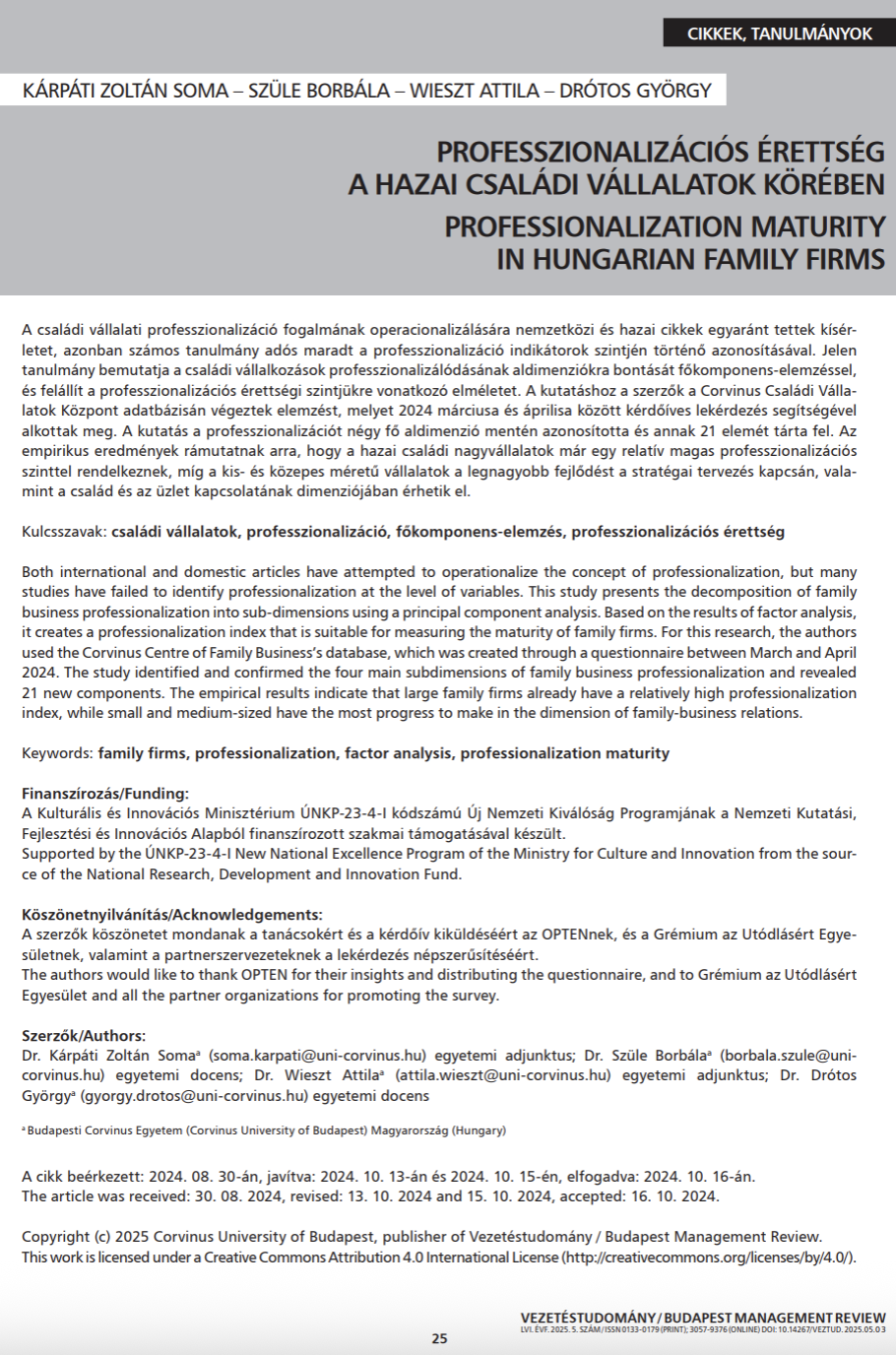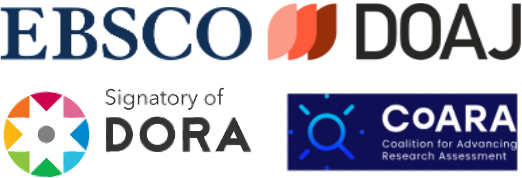Professzionalizációs érettség a hazai családi vállalatok körében
DOI:
https://doi.org/10.14267/VEZTUD.2025.05.03Kulcsszavak:
családi vállalatok, professzionalizáció, főkomponens-elemzés, professzionalizációs érettségAbsztrakt
A családi vállalati professzionalizáció fogalmának operacionalizálására nemzetközi és hazai cikkek egyaránt tettek kísérletet, azonban számos tanulmány adós maradt a professzionalizáció indikátorok szintjén történő azonosításával. Jelen tanulmány bemutatja a családi vállalkozások professzionalizálódásának aldimenziókra bontását főkomponens-elemzéssel, és felállít a professzionalizációs érettségi szintjükre vonatkozó elméletet. A kutatáshoz a szerzők a Corvinus Családi Vállalatok Központ adatbázisán végeztek elemzést, melyet 2024 márciusa és áprilisa között kérdőíves lekérdezés segítségével alkottak meg. A kutatás a professzionalizációt négy fő aldimenzió mentén azonosította és annak 21 elemét tárta fel. Az empirikus eredmények rámutatnak arra, hogy a hazai családi nagyvállalatok már egy relatív magas professzionalizációs szinttel rendelkeznek, míg a kis- és közepes méretű vállalatok a legnagyobb fejlődést a stratégai tervezés kapcsán, valamint a család és az üzlet kapcsolatának dimenziójában érhetik el.
Letöltések
Hivatkozások
Arteaga, R., & Menéndez-Requejo, S. (2017). Family Constitution and Business Performance: Moderating Factors. Family Business Review, 30(4), 320-338. https://doi.org/10.1177/0894486517732438
Bogdány, E., Szépfalvi, A., & Balogh, Á. (2019). Hogyan tovább családi vállalkozások? – Családi vállalkozások utódlási jellemzői és nehézségei. Vezetéstudomány, 50(2), 72-85. https://doi.org/10.14267/ VEZTUD.2019.02.06
Camfield, C., & Franco, M. (2019). Professionalisation of the Family Firm and Its Relationship with Personal Values. The Journal of Entrepreneurship, 28(1), 144-288. https://doi.org/10.1177/0971355718810291
Cattaneo, C. & Bassani, G. (2020). Professionalization and Managerialization in Family Firms: A Still Open Issue. In Leotta, A. (Eds.), Management Controlling and Governance of Family Businesses: Contributions to Management Science (pp. 29-49). Springer. https://doi.org/10.1007/978-3-030-47741-7_3
Chang, S.J., & Shim, J. (2015). When does transitioning from family to professional management improve firm performance? Strategic Management Journal, 36(9), 1297-1316. https://doi.org/10.1002/smj.2289
Christmann, A., & Van Aelst, S. (2006). Robust estimation of Cronbach’s alpha. Journal of Multivariate Analysis, 97(7), 1660-1674. https://doi.org/10.1016/j.jmva.2005.05.012
Chua, J.H., Chrisman, J.J., & Bergiel, E.B. (2009). An Agency Theoretic Analysis of the Professionalized Family Firm. Entrepreneurship Theory and Practice, 33(2), 355-372. https://doi.org/10.1111/j.1540-6520.2009.00294.x
Cronbach, L.J. (1951). Coefficient alpha and the internal structure of tests. Psychometrika, 16, 297-334. https://doi.org/10.1007/BF02310555
De Kok, J.M.P., Uhlaner, L.M., & Thurik, A.R. (2006). Pro-fessional HRM Practices in Family Owned‐Managed Enterprises. Journal of Small Business Management, 44(3), 441-460. https://doi.org/10.1111/j.1540-627X.2006.00181.x
de Leeuw, J. (2006). Principal component analysis of binary data by iterated singular value decomposition. Computational Statistics & Data Analysis, 50(1), 21-39. https://doi.org/10.1016/j.csda.2004.07.010
Dekker, J.C., Lybaert, N., Steijvers, T., Depaire, B., & Mercken, R. (2013). Family Firm Types Based on the Professionalization Construct: Exploratory Research. Family Business Review, 26(1), 81-99. https://doi.org/10.1177/0894486512445614
Dekker, J., Lybaert, N., Steijvers, T., & Depaire, B. (2015). The effect of family business professionalization as a multidimensional construct on firm performance. Journal of Small Business Management, 53(2), 516-538. https://doi.org/10.1111/jsbm.12082
Deng, L. & Chan, W. (2017). Testing the difference between reliability coefficients alpha and omega. Educational and Psychological Measurement, 77(2), 185-203. https://doi.org/10.1177/0013164416658325
Dyer, W.J. (1989). Integrating Professional Management into a Family Owned Business. Family Business Review, 2(3), 221-236. https://doi.org/10.1111/j.1741-6248.1989.00221.x
Fabel, O., Mináriková, D., & Hopp, C. (2022). Differences and similarities in executive hiring decisions of family and nonfamily firms. Journal of Family Business Strategy, 13(2), 1-15. https://doi.org/10.1016/j.jfbs.2021.100481
Fang, H., Memili, E., Chrisman, J.J., & Welsh, D.H. (2012). Family Firm’s Professionalization: Institutional Theory and Resource-Based View Perspectives. Small Business Institute Journal, 8(2), 12-34.
Fellman, S. (2013). Managing Professionalization in Family Business – Transforming Strategies for Managerial Succession and Recruitment in Family Firms in the Twentieth Century in The Endurance of Family Businesses a Global Overview. In Fernandez Perez, P., & Colli, A. (Eds.), The Endurance of Family Businesses: A Global Overview (pp. 248-282). Cambridge University Press. https://doi.org/10.1017/CBO9781139794848.015
Felsmann, B., Ferincz, A., & Kárpáti, Z. (2022). Erőforrások és képességek a vállalati versenyképesség tükrében: Egy empirikus vizsgálat tanulságai. Vezetéstudomány, 53(4), 2–16. https://doi.org/10.14267/VEZTUD.2022.04.01
Flamholtz, E.G., & Randle, Y. (2007). Growing Pain - Transitioning from an Entrepreneurship to a Professionally Managed Firm. Jossey-Bass.
Heidrich, B., & Vajdovich, N. (2021). Quo vadis? – A családi vállalkozások összetett célrendszerének elemzése. Vezetéstudomány, 52(11), 13–27. https://doi.org/10.14267/VEZTUD.2021.11.02
Gersick, K.E., & Feliu, N. (2014). Governing the family enterprise: Practices, performance, and research. In The SAGE handbook of family business (pp. 196-225). SAGE Publication. https://doi.org/10.4135/9781446247556.n11
Gnan, L., Montemerlo, D., & Huse, M. (2013). Governance Systems in Family SMEs: The Substitution Effects between Family Councils and Corporate Governance Mechanisms. Journal of Small Business Management, 53(2), 355–381. https://doi.org/10.1111/jsbm.12070
Gomez-Mejia, L.R., Cruz, C., Berrone, P., & De Castro, J. (2011). The Bind that Ties: Socioemotional Wealth Preservation in Family Firms. The Academy of Management Annals, 5(1), 653–707. https://doi.org/10.5465/19416520.2011.593320
Kaehr Serra, C, & Thiel, J. (2019). Professionalizing entrepreneurial firms: Managing the challenges and outcomes of founder-CEO succession. Strategic Entrepreneurship Journal, 13, 379–409. https://doi.org/10.1002/sej.1329
Kárász, J.T., Nagybányai Nagy, O., Széll, K., & Takács, Sz. (2022). Cronbach-alfa: vele vagy nélküle? Magyar Pszichológiai Szemle, 77(1), 81–98. https://doi.org/10.1556/0016.2022.00004
Kárpáti, Z. (2021). Családi vállalatok professzionalizálódása – Szisztematikus szakirodalmi áttekintés. Vezetéstudomány, 52(3), 53–65. https://doi.org/10.14267/VEZTUD.2021.03.05
Kárpáti, Z. & Drótos, G. (2023). Hogyan professzionalizáljuk a vállalkozásunkat? Egy longitudinális esettanulmány tapasztalatai egy hazai közepes méretű családi vállalkozás példáján keresztül. Vezetéstudomány, 54(2), 53–67. https://doi.org/10.14267/VEZTUD.2023.02.05
Kárpáti, Z., & Ferincz, A. (2024). A professzionalizáció szerepe a hazai közepes méretű családi vállalatok versenyképességében. Vezetéstudomány, 55(3), 2–13. https://doi.org/10.14267/VEZTUD.2024.03.01
Kárpáti, Z., Ferincz, A., & Felsmann, B. (2024). Relationship between different resource and capability configurations and competitiveness – comparative study of Hungarian family and nonfamily firms. Journal of Family Business Management, 14(4), 781-801. https://doi.org/10.1108/JFBM-08-2023-0145
Kline, R.B. (2016). Principles and practice of structural equation modeling (4th edition). The Guilford Press. Központi Statisztikai Hivatal. (2024). A vállalkozások teljesítménymutatói kis- és középvállalkozási kategória szerint. https://www.ksh.hu/stadat_files/gsz/hu/gsz0018.html
Li, X., & Dubes, R.C. (1989). A probabilistic measure of similarity for binary data in pattern recognition. Pattern Recognition, 22(4), 397-409. https://doi.org/10.1016/0031-3203(89)90049-6
Hair, J., Black, W., Babin, B., & Anderson, R.E. (2019). Multivariate Data Analysis (8th edition). Cengage Learning.
Hall, A. & Nordqvist, M. (2008). Professional Management in Family Businesses: Toward an Extended Understanding. Family Business Review, 21(1), 51-69. https://doi.org/10.1111/j.1741-6248.2007.00109.x
Hiebl, M.R., & Mayrleitner, B. (2019). Professionalization of management accounting in family firms: the impact of family membersfamily members. Review of Managerial Science, 13(5), 1037-1068. https://doi.org/10.1007/s11846-017-0274-8
Le Breton-Miller, I., & Miller, D. (2006). Why Do Some Family Businesses Out-Compete? Governance, Long- Term Orientations, and Sustainable Capability. Entrepreneurship Theory and Practice, 30(6), 731-746. https://doi.org/10.1111/j.1540-6520.2006.00147.x
Madison, K., Daspit, J.J., Turner, K., & Kellermans, F.W. (2018). Family firm human resource practices: Investigating the effects of professionalization and bifurcation bias on performance. Journal of Business Research, 84, 327-336. https://doi.org/10.1016/j.jbusres.2017.06.021
Michiels, A., Uhlaner, L., & Dekker, J. (2017). The effect of family business professionalization on dividend payout. Journal of Small Business and Enterprise Development, 24(4), 971-990. https://www.doi.org/10.1108/JSBED-01-2017-0023
Nagy, A.Sz., & Tobak, J. (2017). Családi vállalkozások vezetési és utódlási kérdései. TAYLOR, 9(2), 188-96. https://www.iskolakultura.hu/index.php/taylor/article/view/13116
Németh, K., & Németh, S. (2018). Professzionalizálódó családi vállalkozások Magyarországon. Prosperitas, 5(3), 24–47. https://doi.org/10.31570/prosp_2018_03_2
Noguchi, K., Abel, R.S., Marmolejo-Ramos, F., & Konietschke, F. (2020). Nonparametric multiple comparisons. Behavior Research Methods, 52, 489–502. https://doi.org/10.3758/s13428-019-01247-9
Nordqvist, M., Wennberg, K., Bau, M., & Hellerstedt, K. (2013). An entrepreneurial process perspective on succession in family firms. Small Business Economics, 40(4), 1087-1122. https://doi.org/10.1007/s11187-012-9466-4.
Noszkay, E. (2017). Tapasztalatok a családi vállalkozások átörökítésének dilemmái kapcsán. Vezetéstudomány, 48(6-7), 64-72. https://doi.org/10.14267/VEZTUD.2017.06.08
Ortiz, J., & Gargallo-Castel, A. (2024). Innovation and firm performance: influence of ownership and professionalization. Economics of Innovation and New Technology, 1-23. https://doi.org/10.1080/10438599.2024.2353296
Polat, G. (2021). Advancing the multidimensional approach to family business professionalization. Journal of Family Business Management, 11(4), 555-571. https://doi.org/10.1108/JFBM-03-2020-0020
Polat, G., & Benligiray, S. (2022). The impact of family business professionalization on financial performance: a multidimensional approach. Journal of Small Business and Enterprise Development, 29(7), 1149-1175. https://doi.org/10.1108/JSBED-11-2021-0437
Sallay, V., Wieszt, A., Varga, Sz., & Martos, T. (2024). Balancing identity, construction, and rules: Family relationship negotiations during first-generation succession in family businesses. Journal of Business Research, 174, 1-20, https://doi.org/10.1016/j.jbusres.2023.114483.
Sharma, P. (2004). An overview of the field of family business studies: current status and directions for the future. Family Business Review, 17(1), 1-36. https://doi.org/10.1111/j.1741-6248.2004.00001.x
Sharma, P., Chrisman, J. J., Pablo, A. L., & Chua, J. H. (2001). Determinants of initial satisfaction with the succession process in family firms: A conceptual model. Entrepreneurship Theory and Practice, 25(3), 17- 35. https://doi.org/10.1177/104225870102500302
Songini, L. (2006). The professionalization of family firms: theory and practice. In P.Z. Poutziouris, K.X. Smyrnios, & S.B. Klein (Eds.), Handbook of Research on Family Business (pp. 269-297). Edward Elgar Publishing Limited. https://doi.org/10.4337/9781847204394.00026
Songini, L., Armenia, S., Morelli, C., & Pompei, A. (2024). Managerialization, professionalization and firm performance in family business: A Systems Thinking perspective. Systems Research and Behavioral Science, 41(1), 100-118. https://doi.org/10.1002/sres.2935
Stewart, A., & Hitt, M.A. (2012). Why can’t a family business be more like a nonfamily business? Modes of professionalization in family firms. Family Business Review, 25(1), 58-86. https://doi.org/10.1177/0894486511421665
Suess, J. (2014). Family governance – Literature review and the development of a conceptual model. Journal of Family Business Strategy, 5(2), 138-155. https://doi.org/10.1016/j.jfbs.2014.02.001
Szüle, B. (2017). Comparison of goodness measures for linear factor structures. Hungarian Statistical Review, Special number 2, 147-163. https://doi.org/10.20311/stat2017.k21.en147
Vajda, É., Wieszt, A., & Anand, A. (2024). Fair play in family firms: examining the perceived justice of performance management systems. Journal of Family Business Management, 14(6), 1065-1083. https://doi.org/10.1108/JFBM-05-2024-0094
Vajdovich, N., Heidrich, B., Németh, S., & Németh, K. (2022). From here to eternity: An empirical analysis of the goal system of family wineries. Entrepreneurial Business and Economics Review, 10(4), 155-179. https://doi.org/10.15678/EBER.2022.100410
Vargha, A. (2002). Független minták összehasonlítása új rangsorolásos eljárásokkal. Statisztikai Szemle, 80(4), 328-353.
Waldkirch, M., Melin, L., & Nordqvist, M. (2017). When the cure turns counterproductive: Parallel professionalization in family firms. Academy of Management Proceedings, 1. https://doi.org/10.5465/ambpp.2017.50
Waldkirch, M. (2020). Non-family CEOs in family firms: Spotting gaps and challenging assumptions for a future research agenda. Journal of Family Business Strategy, 11(1), 100305. https://www.doi.org/ 10.1016/j.jfbs.2019.100305
Warrick, D.D. (2017). What leaders need to know about organizational culture. Business Horizons, 60(3), 395- 404. https://doi.org/10.1016/j.bushor.2017.01.011
Wieszt, A., Martos, T., Sallay, V., Varga, Sz., & Vékás, P. (2021). Családi vállalatok utódlása Magyarországon (Kutatási jelentés). Budapesti Corvinus Egyetem. https://unipub.lib.uni-corvinus.hu/7092/1/ResearchReport_hu.pdf
Zimmerman, D.W. (2006). Two separate effects of variance heterogeneity on the validity and power of significance tests of location. Statistical Methodology, 3(4), 351-374. https://doi.org/10.1016/j.stamet.2005.10.002
Zhang, J., & Ma, H. (2009). Adoption of professional management in Chinese family business: A multilevel analysis of impetuses and impediments. Asia Pacific Journal of Management, 26(1), 119-139. https://doi.org/10.1007/s10490-008-9099-y

Downloads
Megjelent
Hogyan kell idézni
Folyóirat szám
Rovat
License
Copyright (c) 2025 Corvinus University of Budapest, publisher of Vezetéstudomány / Budapest Management Review

This work is licensed under a Creative Commons Attribution 4.0 International License.
Authors assign copyright to Vezetéstudomány / Budapest Management Review. Authors are responsible for permission to reproduce copyright material from other sources.

